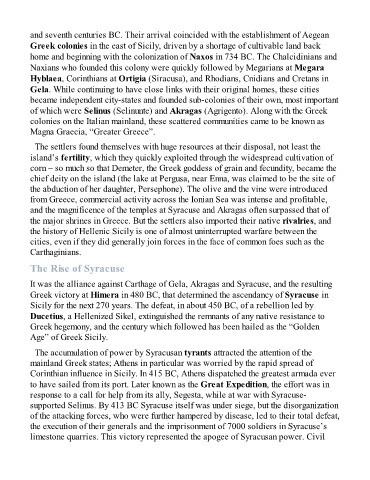Page 561 - The Rough Guide of Sicily
P. 561
and seventh centuries BC. Their arrival coincided with the establishment of Aegean
Greek colonies in the east of Sicily, driven by a shortage of cultivable land back
home and beginning with the colonization of Naxos in 734 BC. The Chalcidinians and
Naxians who founded this colony were quickly followed by Megarians at Megara
Hyblaea, Corinthians at Ortigia (Siracusa), and Rhodians, Cnidians and Cretans in
Gela. While continuing to have close links with their original homes, these cities
became independent city-states and founded sub-colonies of their own, most important
of which were Selinus (Selinunte) and Akragas (Agrigento). Along with the Greek
colonies on the Italian mainland, these scattered communities came to be known as
Magna Graecia, “Greater Greece”.
The settlers found themselves with huge resources at their disposal, not least the
island’s fertility, which they quickly exploited through the widespread cultivation of
corn – so much so that Demeter, the Greek goddess of grain and fecundity, became the
chief deity on the island (the lake at Pergusa, near Enna, was claimed to be the site of
the abduction of her daughter, Persephone). The olive and the vine were introduced
from Greece, commercial activity across the Ionian Sea was intense and profitable,
and the magnificence of the temples at Syracuse and Akragas often surpassed that of
the major shrines in Greece. But the settlers also imported their native rivalries, and
the history of Hellenic Sicily is one of almost uninterrupted warfare between the
cities, even if they did generally join forces in the face of common foes such as the
Carthaginians.
The Rise of Syracuse
It was the alliance against Carthage of Gela, Akragas and Syracuse, and the resulting
Greek victory at Himera in 480 BC, that determined the ascendancy of Syracuse in
Sicily for the next 270 years. The defeat, in about 450 BC, of a rebellion led by
Ducetius, a Hellenized Sikel, extinguished the remnants of any native resistance to
Greek hegemony, and the century which followed has been hailed as the “Golden
Age” of Greek Sicily.
The accumulation of power by Syracusan tyrants attracted the attention of the
mainland Greek states; Athens in particular was worried by the rapid spread of
Corinthian influence in Sicily. In 415 BC, Athens dispatched the greatest armada ever
to have sailed from its port. Later known as the Great Expedition, the effort was in
response to a call for help from its ally, Segesta, while at war with Syracuse-
supported Selinus. By 413 BC Syracuse itself was under siege, but the disorganization
of the attacking forces, who were further hampered by disease, led to their total defeat,
the execution of their generals and the imprisonment of 7000 soldiers in Syracuse’s
limestone quarries. This victory represented the apogee of Syracusan power. Civil

